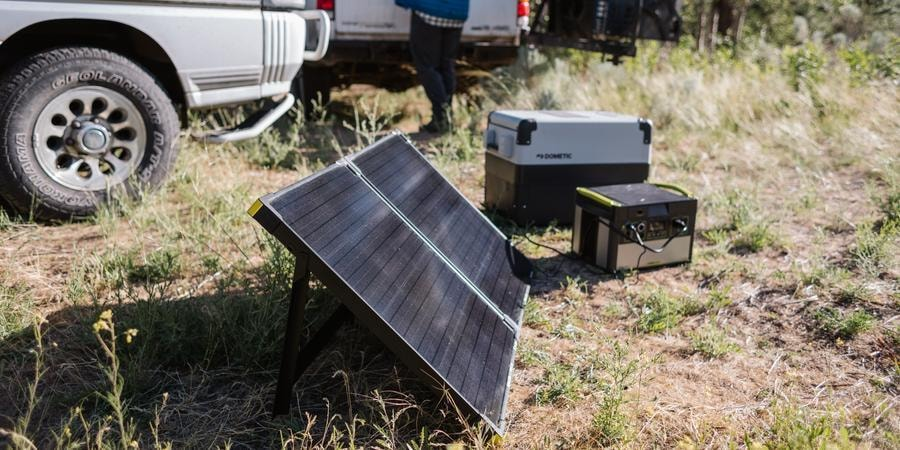Outdoor Adventure: Selecting Solar Chargers and Portable Power Solutions
Whether you're venturing into the wilderness or enjoying off-grid van life, the allure of nature often drives us outdoors to escape the demands of modern life. However, our reliance on electronic devices like smartphones, cameras, and satellite messengers has grown, both to aid our journeys and for safety. As a result, there's a growing need for portable power solutions to keep these devices charged while on the go.
This guide will help you navigate the world of portable power technology and solar charging options to find the best fit for your adventure and travel power needs. We'll cover the power supply chain, various power sources, and types of solar chargers, and offer tips for effective solar charging.
Understanding the Power Supply Chain
To effectively choose the right technology for your needs, it's essential to understand the basic components of the power supply chain. In simple terms, you need a power source (such as home power, vehicle power, or solar power) to charge a portable power device (also called power banks, power stations, chargers, or battery packs), which, in turn, powers your electronic devices (smartphones, GPS units) during your outdoor activities.
| Power SOURCE |
→ |
Power STORAGE |
→ |
Power USE |
|
Electrical charge is supplied to the power bank.
|
|
A portable power device to store energy. These can range from a handheld power bank to a larger power station capable of running small appliances. |
|
Electronic devices using stored energy, including:
|
Power Sources
There are several power sources you can use to charge your portable power devices or electronic gadgets:
Choosing the right power source depends on your location and access to electricity. While wall outlets and car chargers are convenient for pre-trip charging, solar energy becomes invaluable when you're off the grid for an extended period. Solar panels use photovoltaic cells to convert sunlight into electricity, making them a reliable choice for recharging devices in remote areas.
Types of Solar Chargers
Solar chargers come in different configurations, each with its own advantages:
Small/On-Device Solar Chargers: These are integrated into personal devices like lanterns or power banks. They require direct sunlight for optimal performance and can take days to fully charge a device.
Panel-Only Solar Chargers: These panels don't store electricity; you'll need a compatible portable power bank or station to store the collected energy. They range from compact panels suitable for backpacking to larger ones for powering small appliances or emergency use.
Solar Panels with Integrated Batteries: Some solar panels come with built-in batteries, offering a small but sufficient capacity to charge most modern cell phones. These are ideal for users with modest power needs.
Tips on Choosing and Using Solar Chargers
Consider these factors when selecting a solar charger:
Panel Size: Larger panels collect more sunlight at once, charging devices faster. Check the watt rating for maximum power output under ideal conditions.
Portability and Weight: Choose a solar panel suitable for your adventure type. Backpackers may prefer lightweight, compact panels, while vehicle-based travelers may prioritize capacity over weight.
Output Capacity: Solar panels are rated in watts, indicating the electricity generated. Higher values mean more power generated in a given period.
Flexibility: Consider whether you need a semi-flexible or rigid panel based on your activities and mounting options.
Exposure to Sunlight: Solar panels require direct sunlight for efficiency, so consider your travel conditions and whether on-the-go charging is feasible.
Environmental Conditions: Weather, geography, and terrain affect solar charger efficiency. Cloudy skies, terrain obstacles, and shadowy areas can reduce solar panel performance.
Time of Year: Day length and the angle of sunlight in different seasons impact solar panel efficiency. Winter trips may require larger panels to compensate for shorter daylight hours.
Portable Power Banks and Stations
Solar chargers are often used to charge portable power devices (power banks), which then charge electronic devices. Power banks are suitable for short-term power needs and come in various capacities measured in milliamp hours (mAh). On the other hand, power stations are larger, high-capacity devices designed to charge multiple devices simultaneously and may include USB and AC outlets.
Key Specs for Portable Power Devices
Consider the following specifications when choosing a portable power solution:
Storage Capacity: Measured in mAh, Ah, or Wh, storage capacity determines how many recharges you can get for your devices. Calculate your needs based on the capacity of your device's battery.
Power Output: Ensure the power bank's output voltage matches your device's input requirements to avoid issues like draining your device's battery.
Deciding Which Portable Power Solution to Use
To make the right choice, consider:
Trip Duration: Short trips may only require a power bank, while longer off-grid adventures may benefit from a solar charger or generator.
Mode of Travel: Solar chargers are effective with sufficient sunlight exposure, so assess whether your activities align with this requirement.
Battery Type: If your devices use AA batteries, consider a solar charger that can recharge spares while others are in use.
Size and Weight: Evaluate whether the benefits of larger power solutions outweigh their size and weight in your specific situation.
Remember that portable power solutions provide a supplement, not a guarantee. Ensure your devices and power pack are fully charged before your trip, and factor in extra capacity for efficiency and safety.
